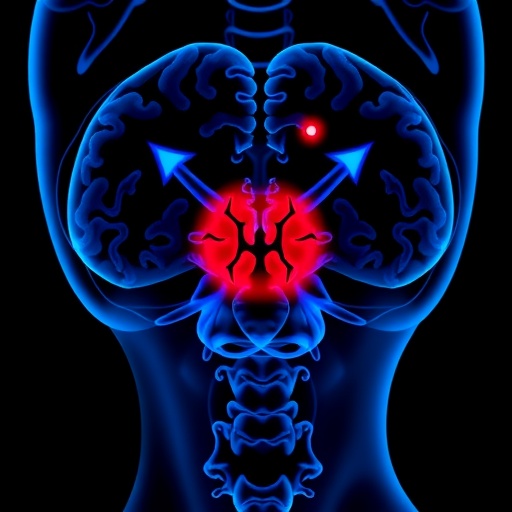In a groundbreaking study that promises to reshape our understanding of viral oncology, researchers at The University of Hong Kong’s LKS Faculty of Medicine have unveiled a novel mechanism by which the Epstein-Barr virus (EBV) orchestrates the progression and metastasis of nasopharyngeal carcinoma (NPC). This common human virus, long associated with NPC—a cancer predominantly affecting populations in Southern China—has now been shown to manipulate the three-dimensional architecture of the human genome within cancer cells, actively driving tumor advancement through a previously unrecognized “hooking” mechanism.
EBV infects over 95% of adults globally, typically during childhood or adolescence, establishing a lifelong but mostly asymptomatic presence. Despite its ubiquity, the virus’s insidious role in oncogenesis has remained elusive until now. NPC, a malignancy arising in the nasopharynx—the region hidden behind the nasal cavity—presents unique clinical challenges, especially because metastasis is a major contributor to mortality. Although standard interventions like radiotherapy and chemotherapy achieve reasonably high initial survival rates, metastatic NPC patients often face drastically reduced five-year survival probabilities, sometimes plummeting to as low as 20-30%.
One of the most intriguing aspects of EBV infection in NPC is that the virus does not integrate itself into the host’s chromosomal DNA. Instead, it maintains itself as extrachromosomal DNA (ecDNA) floating within the cell nucleus. This state, described as an ‘island’ within the genome, allows EBV to evade immune detection effectively while continuing to influence host cell behavior by producing only a limited set of proteins, including the pivotal EBNA1.
The research team, led by Professor Dai Wei, deployed state-of-the-art genomic technologies to illuminate the complex interplay between EBV ecDNA and the human genome inside NPC cells. They discovered a precise physical interaction where EBV “hooks” onto specific regions of the human chromatin, reorganizing its three-dimensional conformation. This structural remodeling affects critical regulatory elements—epigenetic switches—that govern gene expression patterns essential for cell fate and behavior.
Such viral “hooking” fundamentally hijacks the epigenetic machinery within the host cell, effectively rewiring cellular pathways to favor viral persistence and promote oncogenic processes. This dynamic reshaping of chromatin architecture facilitates the evasion of immune surveillance and potentiates the metastatic potential of tumor cells, thus unraveling a convincing mechanism for EBV’s active contribution to cancer progression.
To validate these findings and explore their clinical implications, the team examined tumor samples from 177 NPC patients recently diagnosed across medical centers in Hong Kong and Guangzhou. This extensive cohort analysis allowed the identification of novel genomic signature markers—specific human genes intricately regulated through EBV’s chromatin interactions. These marker genes serve as robust predictors of metastasis risk, providing a molecular window into the aggressiveness of the disease and enabling stratification of patients by their likelihood of disease dissemination.
Current NPC therapies, while effective to an extent, face significant obstacles, particularly the challenge of metastasis and treatment resistance. The discovery of EBV’s structural influence opens new therapeutic vistas by targeting the virus’s hooking interface rather than solely focusing on the tumor cells themselves. Professor Dai and colleagues experimented using epigenetic drugs and the revolutionary gene-editing system CRISPR-Cas9 to sever the viral-host genomic connection. These interventions produced a marked reduction in EBV abundance within cancer cells and decelerated tumor growth, underscoring the therapeutic promise of disrupting EBV’s physical interaction with the genome.
This paradigm shift offers a dual advantage: not only do such targeted therapies aim to suppress tumor progression at its viral root, but they also potentially mitigate the side effects and resistance commonly associated with conventional treatments. Furthermore, the predictive power of EBV-regulated genomic signatures can facilitate personalized medical approaches, enabling clinicians to customize treatments for high-risk NPC patients more effectively.
While the precise molecular details of the hooking mechanism require further elucidation, the research team is committed to deepening the understanding of how EBV anchors itself to chromatin and commandeers host cellular programs post-interaction. Future investigations aim to dissect the downstream signaling cascades and epigenetic modifications instigated by viral contact, intending to uncover additional therapeutic targets to preempt or reverse metastasis.
This pioneering research was conducted through a collaborative effort involving multiple experts within the Department of Clinical Oncology at HKUMed, supported by contributions from leading biostatisticians and microbiologists both locally and internationally, including partnerships with Columbia University and the Sun Yat-sen University Cancer Centre. Strong institutional funding from Hong Kong’s Research Grants Council, the Health Bureau, and other regional science programs underpinned the study’s ambitious scope.
Professor Dai emphasizes the transformative potential of this work: “EBV is not merely a bystander in NPC; it is a dynamic architect of cancer progression. Its ability to physically reconfigure the host genome marks a profound viral strategy that, once understood, can be exploited therapeutically to save lives.” His team’s use of CRISPR technology to disrupt viral hooking represents one of the most promising breakthroughs for future anticancer interventions targeting virus-host genomic interactions.
The broader scientific community eagerly anticipates the next phase of this research, which promises to expand the frontiers of viral oncology and cancer epigenetics. The novel insights into EBV’s three-dimensional genome manipulation not only deepen our fundamental understanding of NPC pathogenesis but also catalyze the development of precision therapies that tackle cancer progression at its molecular genesis. By turning the virus’s own genome-hijacking mechanism against it, this research heralds a new era in combating virus-associated cancers, with the potential to significantly improve clinical outcomes for thousands of patients worldwide.
Subject of Research: Cells
Article Title: Virus-human chromatin interactions reorganise 3D genome and hijack KDM5B for promoting metastasis in nasopharyngeal carcinoma
News Publication Date: 4-Aug-2025
Web References:
https://www.nature.com/articles/s41467-025-61597-1
http://dx.doi.org/10.1038/s41467-025-61597-1
References:
Published in Nature Communications
Image Credits: The University of Hong Kong
Keywords: Health and medicine, Human health
Tags: cancer progression mechanismsclinical challenges in nasopharyngeal carcinomaEBV infection and oncogenesisEpstein-Barr virus mechanismsextrachromosomal viral presence in cancerhuman genome architecture manipulationLKS Faculty of Medicine researchnasopharyngeal cancer metastasisSouthern China cancer epidemiologysurvival rates in metastatic NPCtargeted therapies for NPCviral oncology research





